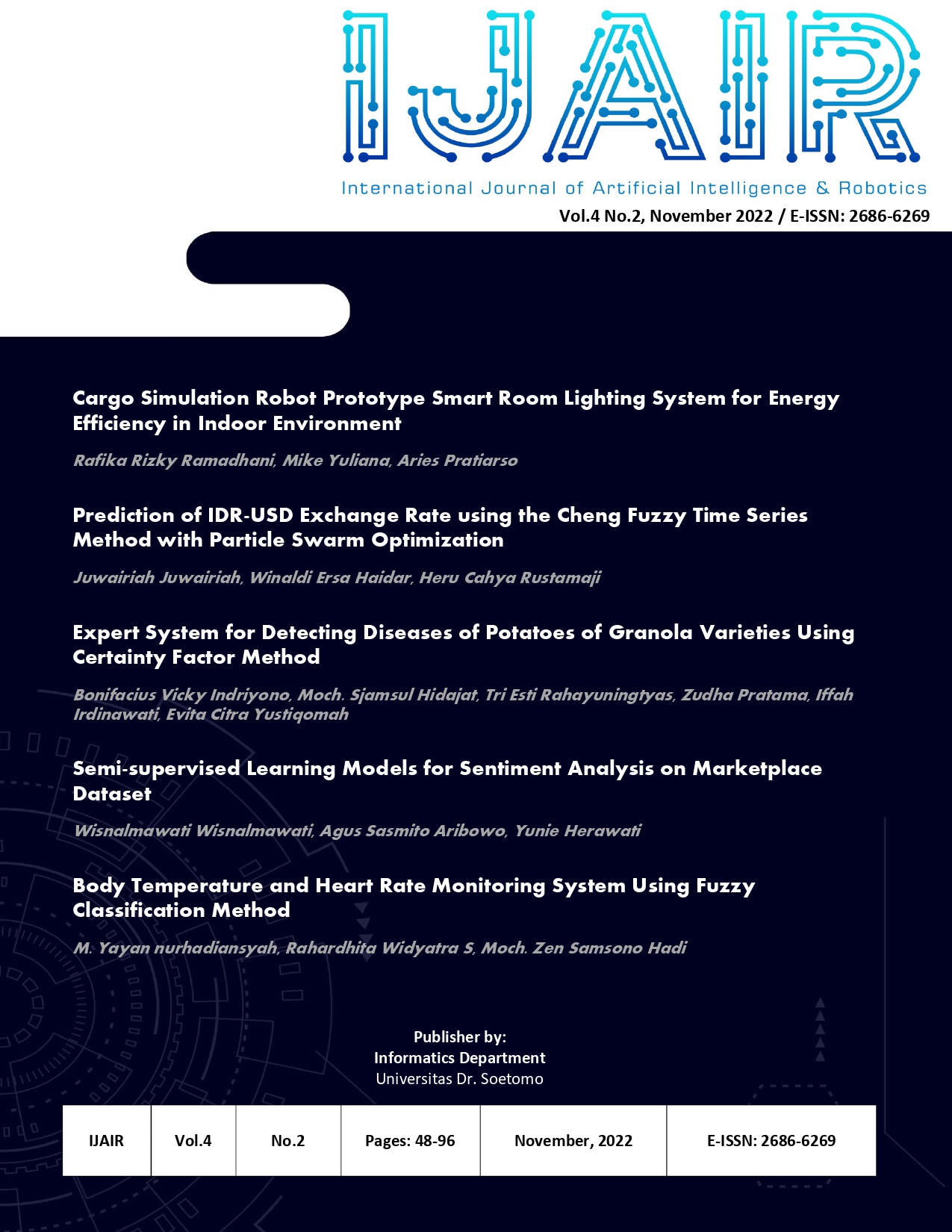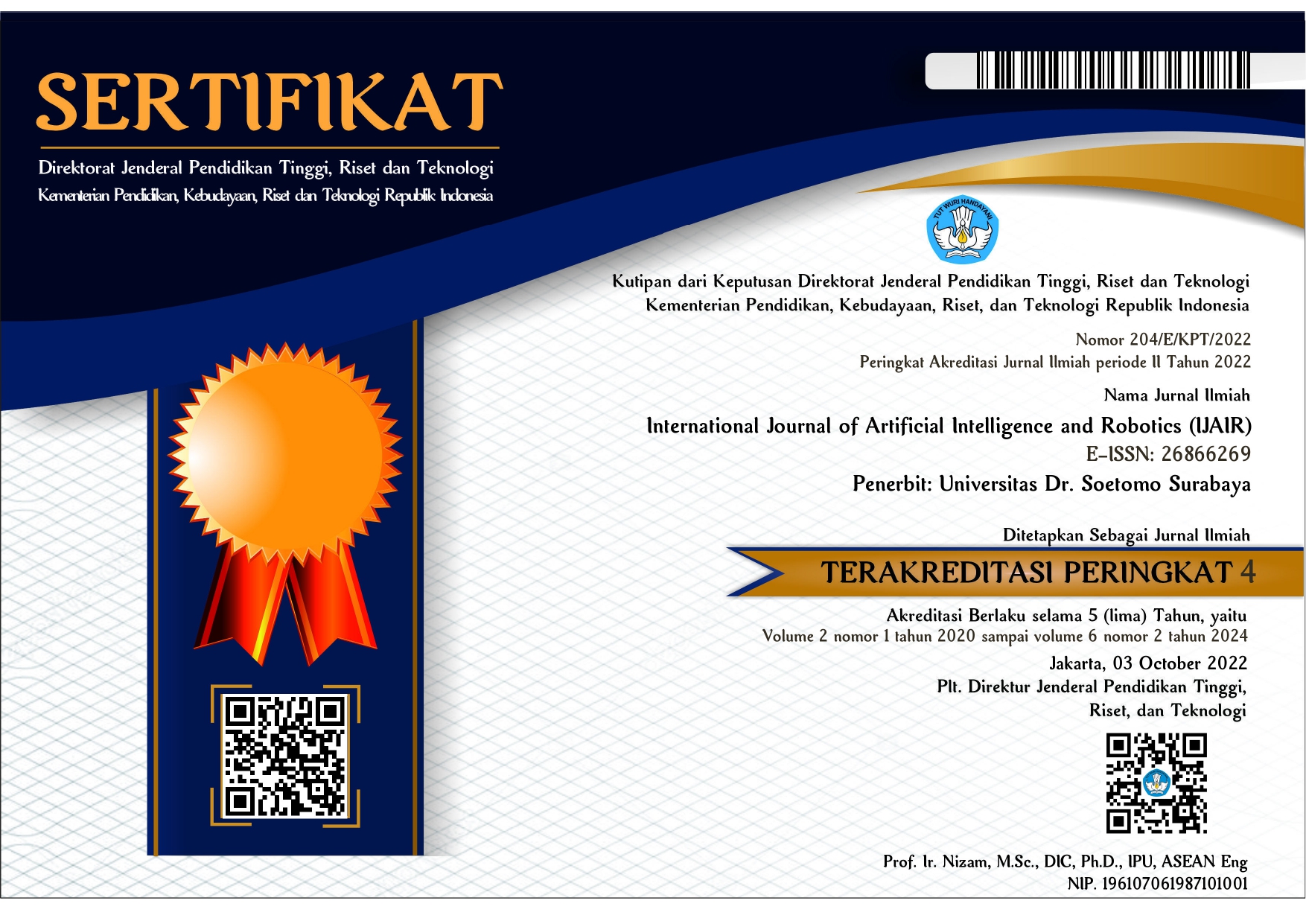Prediction of IDR-USD Exchange Rate using the Cheng Fuzzy Time Series Method with Particle Swarm Optimization
 Abstract views: 385
,
Abstract views: 385
,
 PDF downloads: 381
PDF downloads: 381
Abstract
Currently, much research on machine learning about prediction has been carried out. For example, to predict the exchange rate of the rupiah against the United States currency, namely the United States Dollar (USD). The continuing trend of USD depreciation has attracted many researchers to explore currency trading, especially in establishing an efficient method for predicting fluctuating exchange rates. The rapid development of time series prediction methods has resulted in many methods that can predict data according to needs. In this study, we apply the Fuzzy Time Series Cheng method with Particle Swarm Optimization (PSO) to predict the IDR exchange rate against USD. The data used in this research is sourced from Bank Indonesia in the form of time series data on the selling and buying exchange rate. The FTS Cheng method forecasts the IDR exchange rate against USD. In contrast, the PSO algorithm optimizes the interval parameter to increase the forecasting accuracy. Based on the implementation and the results of the tests, the results show that using the PSO algorithm can produce the best optimization interval parameters and increase the accuracy value. From the results of 10 trials with training data, testing data, and different iterations, it was obtained that the MAPE test for predicting the rupiah exchange rate against the US dollar using FTS Cheng with 60% training data and 40% testing data resulted in the lowest MAPE of 0.610145%. Furthermore, 70% of the training and 30% of the testing data resulted in the lowest MAPE of 0.313388%. Then the FTS Cheng and PSO testing with 60% training data and 40% testing data, and an iteration value of 200 resulted in the lowest MAPE of 0.394707%. Furthermore, 70% of training data and 30% of testing data and an iteration value of 90 resulted in the lowest MAPE of 0.263666%.
Downloads
References
R. Efendi, Z. Ismail, and M. M. Deris, “Improved weight fuzzy time series as used in the exchange rates forecasting of us dollar to Ringgit Malaysia,” Int. J. Comput. Intell. Appl., vol. 12, no. 1, pp. 1–19, 2013.
R. R. Elvierayani, “Peramalan Nilai Tukar ( Kurs ) Rupiah Terhadap Dolar Tahun 2017 dengan Menggunakan Metode Arima Box-Jenkins,” Pros. SI MaNIs (Seminar Nas. Integr. Mat. dan Nilai Islam., vol. 1, no. 1, pp. 253–261, 2017.
I. Suyahya, “Prediksi Nilai Tukar Rupiah Menggunakan metode Mamdani,” vol. 8, no. 1, 2016.
Sriyana, S. Martha, and E. Sulistianingsih, “Prediksi Nilai Tukar Dollar Amerika Serikat terhadap Rupiah dengan Metode Support Vector Regression (SVR),” vol. 08, no. 1, pp. 1–8, 2015.
Li. X. Hui and B. Yusoff, “Exchange Rate Forecasting Using Fuzzy Time Series-Markov Chain,” Univ. Malaysia Teren. J. Undergrad. Res., vol. 3, no. 3, pp. 183–194, 2021.
Q. Song and B. S. Chissom, “Forecasting enrollments with fuzzy time series — Part I,” Fuzzy Sets Syst., vol. 54, no. 1, pp. 1–9, 1993.
L. Abdullah and I. Taib, “High order fuzzy time series for exchange rates forecasting,” Conf. Data Min. Optim., no. June, pp. 1–5, 2011.
Y. Ujianto and M. I. Irawan, “Perbandingan Performansi Metode Peramalan Fuzzy Time Series yang Dimodifikasi dan Jaringan Syaraf Tiruan Backpropagation (Studi Kasus: Penutupan Harga IHSG),” J. Sains Dan Seni ITS, vol. 4, no. 2, pp. 31–36, 2016.
C. A. Prasojo, B. D. Setiawan, and M. Marji, “Optimasi Fuzzy Time Series Menggunakan Algoritma Particle Swarm Optimization Untuk Peramalan Jumlah Penduduk Di Kabupaten Probolinggo,” J. Pengemb. Teknol. Inf. dan Ilmu Komputer; Vol 2 No 8, 2018.
M. O. Okwu and L. K. Tartibu, “Particle Swarm Optimisation BT - Metaheuristic Optimization: Nature-Inspired Algorithms Swarm and Computational Intelligence, Theory and Applications,” M. O. Okwu and L. K. Tartibu, Eds. Cham: Springer International Publishing, 2021, pp. 5–13.
S. M. Chen and B. D. H. Phuong, “Fuzzy time series forecasting based on optimal partitions of intervals and optimal weighting vectors,” Knowledge-Based Syst., vol. 118, pp. 204–216, 2017.
S. M. Chen, X. Y. Zou, and G. C. Gunawan, “Fuzzy time series forecasting based on proportions of intervals and particle swarm optimization techniques,” Inf. Sci. (Ny)., vol. 500, pp. 127–139, 2019.
R. C. Ika, B. D. Setiawan, and Marji, “Optimasi Fuzzy Time Series Menggunakan Algoritme Particle Swarm Optimization untuk Peramalan Nilai Pembayaran Penjaminan Kredit Macet,” J. Pengemb. Teknol. Inf. dan Ilmu Komput. Univ. Brawijaya, vol. 2, no. 6, pp. 2364–2373, 2018.
S. Lin, K. Shi, and H. Ye, “Exchange rate volatility and trade: The role of credit constraints,” Rev. Econ. Dyn., vol. 30, pp. 203–222, 2018.
Novrido Charibaldi, Nur Heri Cahyana, and Muhamad Setiawan Wicaksono, “Optimization of Foodstuffs for Patients with Hypertension Using the Improved Particle Swarm Optimization Method,” Int. J. Artif. Intell. Robot., vol. 4, no. 1, pp. 31–38, 2022.
P. Singh and B. Borah, “Forecasting stock index price based on M-factors fuzzy time series and particle swarm optimization,” Int. J. Approx. Reason., vol. 55, no. 3, pp. 812–833, 2014.
A. D. A. Rifandi, B. D. Setiawan, and Tibyani, “Optimasi Interval Fuzzy Time Series Menggunakan Particle Swarm Optimization pada Peramalan Permintaan Darah : Studi Kasus Unit Transfusi Darah Cabang - PMI Kota Malang,” J. Pengemb. Teknol. Inf. dan Ilmu Komput. Univ. Brawijaya, vol. 2, no. 7, pp. 2770–2779, 2018.
S. Sumartini, M. N. Hayati, and S. Wahyuningsih, “Peramalan Menggunakan Metode Fuzzy Time Series Cheng,” EKSPONENSIAL; Vol 8 No 1, Dec. 2017.
T. Fahmi, Sudarno, and Y. Wilandari, “Perbandingan metode pemulusan eksponensial tunggal dan fuzzy time series untuk memprediksi indeks harga saham gabungan,” J. Gaussian, vol. 2, no. 2, pp. 137–146, 2013.
Copyright (c) 2022 Juwairiah Juwairiah

This work is licensed under a Creative Commons Attribution-ShareAlike 4.0 International License.
Authors who publish with International Journal of Artificial Intelligence & Robotics (IJAIR) agree to the following terms:
-
Authors retain copyright and grant the journal right of first publication with the work simultaneously licensed under a Creative Commons Attribution License (CC BY-SA 4.0) that allows others to share the work with an acknowledgment of the work's authorship and initial publication in this journal.
-
Authors are able to enter into separate, additional contractual arrangements for the non-exclusive distribution of the journal's published version of the work (e.g., post it to an institutional repository or publish it in a book), with an acknowledgment of its initial publication in this journal.
-
Authors are permitted and encouraged to post their work online (e.g., in institutional repositories or on their website) prior to and during the submission process, as it can lead to productive exchanges, as well as earlier and greater citation of published work.















